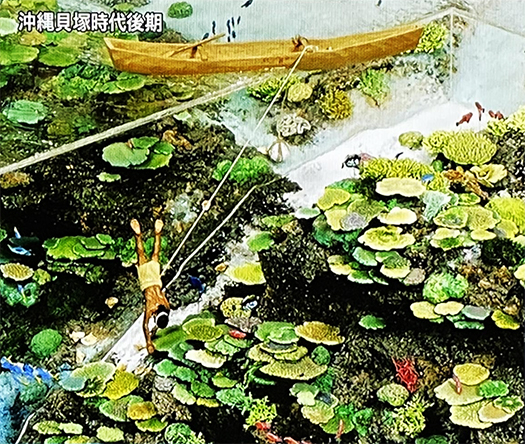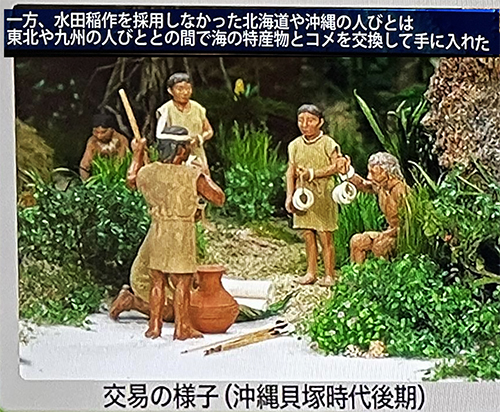


さて国立歴史民俗博物館の先史時代から国家創成期までの展示の
大更新に突き動かされ、それを学び日本史を再学習する意味のブログシリーズ、
「日本列島37,000年史」ですが、明日からは次の国家創成期に移りたい。
考古発見事実に基づいた歴史の再構築と思えて、突き動かされてきました。
そういう意味では以降は文献資料も多くなってくる時代なので
最大の興味分野になってくるでしょう。
・・・というところですが、先日北海道島の異質な状況についても触れた。
独自の文化スタイルを維持した様子は北海道人なので学習もしています。
いろいろな遺跡などにも足を運んでまざまざと実感がある。
一方で、沖縄についてはあんまり考古を知らない。
一応、那覇の博物館などは見学しているけれどあんまりピンとこなかった。
グスク時代(12-16世紀頃)以前の社会の実相はどうも不明。
沖縄では稲作の弥生時代はなくその時代は主に漁撈中心の生業が考えられている。
そのために貝塚時代後期、あるいは弥生・古墳並行時代と呼ばれる。
代表的な貝塚遺跡といわれる沖縄県うるま市「宇堅貝塚」ではゴホウラ製貝輪2点、
イモガイ製貝輪6点、方格規矩鏡破片3点などが出土。
ほかにガラス玉、板状鉄斧、砥石、弥生後期土器などが出土している。
しかし社会の実相研究が進んでいるとは言い切れない。国立歴史民俗博物館や、
沖縄県立博物館の研究成果などに今後期待していきたいところ。
で、国立歴史民俗博物館展示では上のようなイメージが創作されていた。
沖縄や奄美地域では珊瑚礁地形環境に適応した「貝塚文化」とまとめられている。
いかにも海人族的なライフスタイルと言えるでしょうか。
なので結果としては貝類などを採集して肉身を食したあと、
その貝殻を一定加工して本土に「交易品」として提供し、
対価としてコメや鉄器などの有用物資を獲得するライフスタイル。
環境要件は違いがあるけれど北海道の「続縄文」と似た生業なのでしょうか。
北海道では「農耕」は明治期まで本格的には開始しなかった。
その結果、政治権力のようなものも「部族」的な首長制がみられる程度。
それに対して沖縄ではグスク期が12-15世紀にははじまり、そこで
農耕が普遍化開始した途端にグスク(城郭)と政治・戦争、軍事が世を覆う。
やはり農耕が政治とか権力とかの基盤であることを端的に表している。
さて農耕は現代までの人口増加をもたらしたけれど、ネクスト社会は
この増加した人口を維持し続けていけるのかどうか。
農耕とは人類の巨視的な地球気候対応だとすれば、逆に農耕が成立しにくい環境が
今後生起する可能性もあるのだとも思う。
また世界はむしろ社会的原因で人口減少局面を迎えてきているとも思う。
「地球の意思」は人類をどうしようとしているのでしょうか?
・・・これで弥生の世は終了し、いよいよ日本国家創成期へ。
English version⬇
Okinawa’s Shell Mound Culture, Agriculture, and War Society 37,000 Years of Japanese History-37
Okinawa began agriculture around the 12th century. Okinawa began agriculture around the 12th century and entered the age of warring gusuku. Proof that agriculture was the foundation of politics, war, and power. …
Now, the National Museum of Japanese History and Folklore’s exhibition from the prehistoric age to the founding of the nation
I was motivated by the great renewal of the National Museum of Japanese History’s exhibition from the prehistoric age to the period of the nation’s founding.
Tomorrow, I would like to move on to the next topic, the period of the founding of the nation.
I have been motivated by the idea of reconstructing history based on archaeological findings.
In that sense, it’s a period that will have a lot of literary materials from then on.
This will be my greatest field of interest.
I mentioned the other day the heterogeneous situation of the island of Hokkaido.
I am also learning about how they maintained their own unique cultural style because I am a Hokkaido native.
I have visited various archaeological sites and have a vivid sense of it.
On the other hand, I do not know much about the archaeology of Okinawa.
I have visited a museum in Naha, but it didn’t really hit me.
The reality of the society before the Gusuku period (12th to 16th century) is still unclear.
In Okinawa, there was no Yayoi period when rice was cultivated, and the main occupation during that period is thought to have been fishing.
For this reason, it is called the late shell mound period or the parallel Yayoi and Kofun periods.
Uken Shell Mound in Uruma City, Okinawa Prefecture, which is said to be a representative shell mound site, has two gohora shell rings and six mussel shell rings.
At Uken Shell Mound in Uruma City, Okinawa Prefecture, two gohora shell rings, six mussel shell rings, and three pieces of square rectangular mirrors have been excavated.
In addition, glass beads, plate iron axes, whetstones, and pottery from the late Yayoi period have also been excavated.
However, it cannot be said that research on the actual state of society has progressed. The National Museum of Japanese History and Folklore, the Okinawa Prefectural Museum, and other museums have conducted research on the actual state of society.
The National Museum of Japanese History and Okinawa Prefectural Museum’s research results will be expected in the future.
In the National Museum of Japanese History exhibition, the above image was created.
In the Okinawa and Amami areas, it is summarized as “shell mound culture” adapted to the coral reef topography environment.
How can we say that this is a very sea people lifestyle?
So, as a result, after gathering shellfish and other animals and eating their flesh.
After gathering shellfish and eating the meat, the shells were processed and offered to the mainland as “trade goods” in exchange for rice and ironware.
In exchange, they acquired useful commodities such as rice and ironware.
Although there are differences in environmental requirements, is this lifestyle similar to that of the “Sequel to Jomon” in Hokkaido?
In Hokkaido, “agriculture” did not begin in earnest until the Meiji period.
As a result, political power was limited to a “tribal” chief system.
In Okinawa, on the other hand, the Gusuku period began in the 12th-15th century, and it was there that agriculture began to become universal.
As soon as agriculture became universalized, gusuku (castles), politics, war, and military affairs dominated the world.
This is a clear indication that agriculture is the foundation of politics and power.
Agriculture has brought about population growth up to the present day, but the next society must be able to sustain this increase in population.
Can the next society sustain this increase in population?
If agriculture is mankind’s macroscopic response to the global climate, there is a possibility that an environment will arise in the future that will make it difficult for agriculture to be established.
If agriculture is a macroscopic response to the global climate, there is a possibility that an environment will arise in the future that will make it difficult for agriculture to take root.
I also believe that the world is entering a phase of population decline due to social causes.
What does the “will of the earth” have in store for mankind?
…With this, the Yayoi period has come to an end, and we are finally entering the period of the creation of the Japanese nation.
Posted on 12月 7th, 2022 by 三木 奎吾
Filed under: 日本社会・文化研究, 歴史探訪







コメントを投稿
「※誹謗中傷や、悪意のある書き込み、営利目的などのコメントを防ぐために、投稿された全てのコメントは一時的に保留されますのでご了承ください。」
You must be logged in to post a comment.